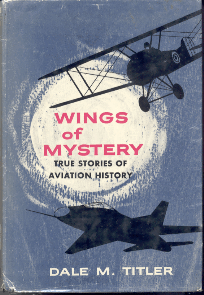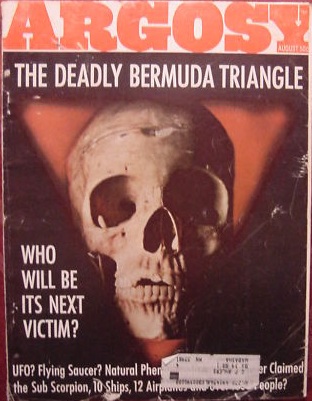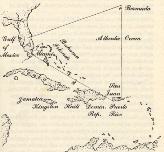|
“The region involved, a watery triangle bounded roughly by Florida, Bermuda, and Puerto Rico, measures less than a thousand miles on any one side.”
. . .So George X. Sand introduced the Triangle to his readers in October 1952 in a short article f or Fate magazine. It was entitled “Sea Mystery at our Back Door.” or Fate magazine. It was entitled “Sea Mystery at our Back Door.”
Sand’s article recounted the latest disappearance (the s.s. Sandra in 1950) and went on to discuss some of the other recent baffling mysteries like the disappearance of airliners NC16002, Star Tiger and Star Ariel. The rest of the article was essentially devoted to the disappearance of Flight 19.
The Triangle remained a colloquial expression throughout the 1950s, employed by locals when another disappearance or unexplained crash happened.
In the early 1960s, its aura grew exponentially. A sensational bit in the April 1962 edition of American Legion magazine by Allan W. Eckert would set the tempo for theorizing thereafter. Eckert’s article was devoted to Flight 19 (“The Mystery of the Lost Patrol”) and Eckert introduced some of the most popular but erroneous dialogue purported coming from the flight leader of the flight, including lines like “the ocean looks strange;” all “the compasses are going haywire;” and that they could not make out  any directions. In his 1962 book, Wings of Mystery, author Dale Titler took it further. He devoted pages in Chapter 14— “The Mystery of Flight 19”— to recounting the most recent incidents of disappearances and even called the area “The Deadly Triangle.” He also began to ponder theories based on electromagnetic anomalies. His book was the first to seriously contemplate that natural but very unusual forces contributed to Flight 19’s disappearance and thus these could also be the cause of the other strange disappearances in the area. any directions. In his 1962 book, Wings of Mystery, author Dale Titler took it further. He devoted pages in Chapter 14— “The Mystery of Flight 19”— to recounting the most recent incidents of disappearances and even called the area “The Deadly Triangle.” He also began to ponder theories based on electromagnetic anomalies. His book was the first to seriously contemplate that natural but very unusual forces contributed to Flight 19’s disappearance and thus these could also be the cause of the other strange disappearances in the area.
The popularity of the subject was beginning to spread beyond the area of the Atlantic seaboard. But the moniker “Deadly Triangle” contained absolutely no geographic reference in it— in other words, “Deadly Triangle” could be anywhere.
Then in February 1964 a largely obscure journalist named Vincent Gaddis wrote an article for Argosy magazine. The article was little different from others, though it added a few more recent cases like the disappearance of the 504-foot sulphur tanker Marine Sulphur Queen. However, it  was his title that finally clicked with the public: “The Deadly Bermuda Triangle.” Adding “Bermuda” finally materialized the location for everybody. In his popular 1965 book Invisible Horizons, Gaddis devoted Chapter 13 to “The Triangle of Death.” was his title that finally clicked with the public: “The Deadly Bermuda Triangle.” Adding “Bermuda” finally materialized the location for everybody. In his popular 1965 book Invisible Horizons, Gaddis devoted Chapter 13 to “The Triangle of Death.”
The concept of the Bermuda Triangle was spreading rapidly. Argosy scored again with a popular article by naturalist Ivan Sanderson in 1968. The cover has gone down in art history. In Turkey bumper stickers were even copied from it.
Ironically, the first book entirely devoted to the subject didn’t carry the word “triangle” at all. It was entitled Limbo of the Lost (1969). The author, John Spencer, proposed the area had no real shape at all and elaborately tried to include the Gulf of Mexico as well as the New Jersey coasts. It sold in limited quantities, but was later reproduced in mass paperback by Bantam and sold over 1,000,000 copies.

- The Deadly Triangle as it appeared in a 1962 book Wings of Mystery
by Dale Titler. The idea that Vincent Gaddis invented the shape
and mystery is nonsense. It had long been popular before his time.
Dozens of magazine and newspaper articles came out in the late ’60s and early ’70s, each author offering a general shape and location to the Triangle. Ivan Sanderson was sure the “Triangle” was an oblong shape centered almost entirely north of Bermuda. In 2 Bantam paperbacks entitled The Devil’s Triangle I and Devil’s Triangle II local Miami journalist Richard Winer proposed it was a trapezium and he extended it nearly to the Azores.
But no book sold as well as Charles Berlitz’s 1974 bestseller, The Bermuda Triangle. Selling way over 5,000,000 copies in hardback, it became an international phenomenon. Berlitz also cautioned about believing in a precise shape to the phenomenon, as had the others. But to this day “Bermuda Triangle” is deferred to for the same reason “Deadly Triangle” failed— there is simply no other name that calls to mind the general area as does Bermuda Triangle.
|